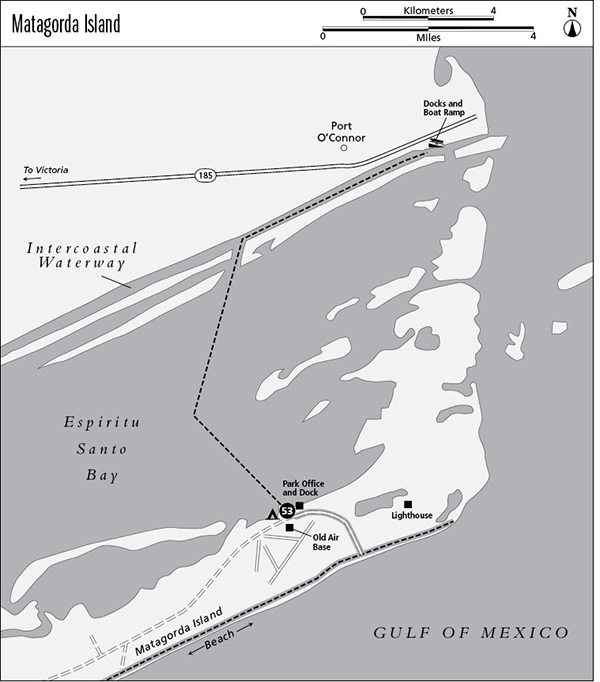
53 Matagorda Island Wildlife Management Area
A day hike across and along the beach of an uninhabited barrier island noted for a historic lighthouse and whooping cranes.
Distance: 38 miles of trails available
Approximate hiking time: Variable
Elevation: Sea level to 10 feet
Trail surface: Sandy road, firm sand of beach
Best season: Fall through spring
Water availability: None
Land status: State wildlife management area
Nearest town: Port O’Connor
Fees and permits: A Limited Public Use permit is required for access and camping and can be obtained at Texas Parks and Wildlife offices at state parks or wildlife management areas.
Maps: USGS Pass Cavallo SW and Long Island; Matagorda Island Wildlife Management Area map
Trail contacts: Matagorda Island Wildlife Management Area, 1700 7th Street, Bay City 77414; (979) 244-6804
Finding the trailhead: Matagorda Island has the most unusual access of any hike in this guide. There is no causeway or bridge to the island, so a boat is necessary to get to the island. The Texas Parks and Wildlife Department used to run a ferryboat to the island on weekends and holidays from the docks in Port O’Connor (on the coast about 40 miles southeast of Victoria) but have stopped doing so because of budget constraints. To access the island now you will need to bring a boat or charter one in Port O’Connor. Be sure to obtain a navigation map in Port O’Connor to be able to find your way to the docks on the bay side of the island. You should be experienced in boating on Texas bays before attempting the crossing to the island.
The Hike
Matagorda Island is one of only two major barrier islands along the lengthy Texas coast that is not connected to the mainland by a causeway or bridge. Hence, the 38-mile-long island is almost completely undeveloped. No condos, hotels, fishing cabins, marinas, power lines, or other developments mar its shores. Only a ranch house or two, an 1852-vintage lighthouse, and the remnants of an abandoned Air Force base now used by the Texas Parks and Wildlife Department occupy the island.
The 56,000-acre island was originally occupied by the Karankawa Indians. Europeans such as Cabeza de Vaca visited the island soon after the white man first appeared in the New World. Eventually ranching became the primary activity on the island before the state and federal governments acquired the island from private owners. Today Matagorda is managed jointly by the state and federal governments as Matagorda Island Wildlife Management Area and Matagorda Island National Wildlife Refuge.
The island is famous for its plentiful birdlife. Well over 300 species of birds use the island as a permanent home, winter home, or migration stopover point. Deer and coyotes roam the interior grasslands, while alligators lurk in numerous ponds. Nineteen threatened or endangered species, including whooping crane, peregrine falcon, and Kemp’s Ridley sea turtle, find refuge on Matagorda.
The hike can be of almost any length desired. After arriving at the docks on the bay side of the island, follow the main road southeast past the old air base runways and across the grassy island to the Gulf beaches on other side. Hike as far up and down the beach as you desire. A short side trip will take you to the prominent 1852 lighthouse near the middle of the island.
The island is a classic Texas barrier island, with broad sandy beaches its entire length. Inland from the beach lie dune ridges; flat, grassy barrier flats; and finally the fertile marshes lining the bay. Unfortunately, also common to all Texas barrier islands, any trash thrown anywhere in or washed into the Gulf of Mexico usually finds its way onto the beaches. It makes for a depressing multinational mix of garbage.
The island is very hot and humid in summer, but you do have the water to cool you off. Bring plenty of water, food, clothing, insect repellent, and other supplies; there are none on the island. Also there is virtually no shade other than near the docks, so bring sunscreen, a hat, and possibly a tent or beach umbrella. Be wary of jellyfish and stingrays on the beach and in the surf. Swim carefully; there are no lifeguards and occasionally undertows can be dangerous. Camping is allowed near the docks and on certain beach areas. Mosquitoes can be vicious inland from the beach, especially in the evening, so come prepared.
All the warnings aside, Matagorda Island makes a great trip. There aren’t many places in United States where you can find more than 38 miles of undeveloped, almost empty beach. To get around more of the island, consider bringing a mountain bike along to complement the hike. Because there is no set route for this hike, no mile-by-mile detail is provided for this hike.
